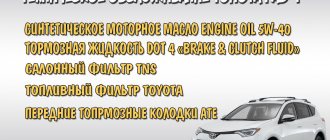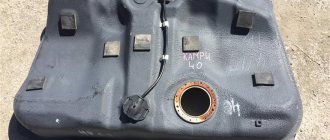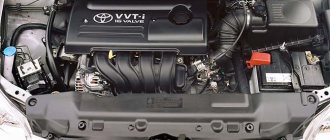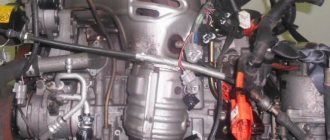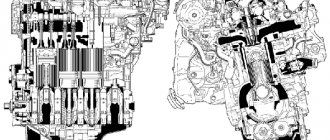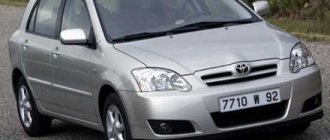In 2021, Toyota introduced a new line of engines under the general name “Dynamic Force Engines”. In fact, this is a product of modernization of the 3 and 4 series engines. Installed on Toyota Camry V70, Toyota RAV 4, Toyota Avalon, mid-size Lexus models.
A25A-FKS is one of the engines in the new line. During the design, the goal was to improve power characteristics without sacrificing efficiency, which was ultimately achieved. The engine operates on the Miller cycle, has 4 cylinders in a row, and is mounted transversely.
Engine A25A-FKS
The ratio of the length and diameter of the cylinder is such that the piston accelerates to a record speed for Toyota engines. This increases performance, but at the cost of increased wear on the piston rings and liner walls. Spraying wear-resistant materials onto the edges of the piston rings made it possible to compensate for this effect.
The compression ratio of this engine is quite high - 1:13. Despite this, internal combustion engines are designed for gasoline with an octane rating of 92-95, which is facilitated by an advanced engine management system. With such a compression ratio, in our conditions, it may be more expedient to use A-98 fuel.
Specifications A25A-FKS
| engine's type | In-line, 4-cylinder |
| Working volume, cubic cm | 2487 |
| Maximum power, hp | 199 — 203 |
| Maximum torque, N*m at rpm. | 243 / 5000 249 / 5000 |
| Fuel used | Gasoline AI-92.95 |
| Average fuel consumption, l/100 km (for Toyota Camry) | 6,9 — 7,2 |
| Supply system | Combined injection D4-S |
| Maximum power, hp (kW) at rpm | 199 (146) / 6600 200 (147) / 6600 203 (149) / 6600 |
| Compression ratio | 1:13 |
| Cylinder diameter, mm | 87,5 |
| Piston stroke, mm | 103,4 |
| CO2 emissions, g/km | 163 |
| Number of valves per cylinder | 4 |
| Start-stop system | Yes |
| Variable phases | DVVTi |
| Environmental standards | Euro 5 |
| Oil consumption, g/1000 km | up to 1000 |
| Oil volume, l | 4,5 |
| frequency of oil changes, thousand km | 7-10 |
| Engine life, thousand km | more than 300 |
| HP boost potential | more than 300 |
For Europe
restyling, 2nd generation, 08.2003 - 12.2005, Jeep/SUV 3 doors.
| Equipment | Release period | Price | Engine make | Body brand |
| 1.8 l, 125 hp, Gasoline, manual transmission, Front (FF) | ||||
| 1.8MT Sol | 09.2003 — 12.2005 | 1ZZ-FE | ZCA25 | |
| 1.8MT Executive | 09.2003 — 12.2005 | 1ZZ-FE | ZCA25 | |
| 2.0 l, 150 hp, Gasoline, manual transmission, all-wheel drive (4WD) | ||||
| 2.0MT 4WD Sol | 09.2003 — 12.2005 | 1AZ-FE | ACA20 | |
| 2.0MT 4WD Executive | 09.2003 — 12.2005 | 1AZ-FE | ACA20 | |
| 2.0 l, 150 hp, Gasoline, automatic transmission, all-wheel drive (4WD) | ||||
| 2.0 AT 4WD Sol | 09.2003 — 12.2005 | 1AZ-FE | ACA20 | |
| 2.0 AT 4WD Executive | 09.2003 — 12.2005 | 1AZ-FE | ACA20 | |
| 2.0 l, 116 hp, Diesel, manual transmission, all-wheel drive (4WD) | ||||
| 2.0MT 4WD Sol | 09.2003 — 12.2005 | 1CD-FTV | CLA20 | |
| 2.0MT 4WD Executive | 09.2003 — 12.2005 | 1CD-FTV | CLA20 |
restyling, 2nd generation, 08.2003 - 12.2005, Jeep/SUV 5 doors.
| Equipment | Release period | Price | Engine make | Body brand |
| 1.8 l, 125 hp, Gasoline, manual transmission, Front (FF) | ||||
| 1.8MT Sol | 09.2003 — 12.2005 | 1ZZ-FE | ZCA26 | |
| 1.8MT Executive | 09.2003 — 12.2005 | 1ZZ-FE | ZCA26 | |
| 2.0 l, 150 hp, Gasoline, manual transmission, all-wheel drive (4WD) | ||||
| 2.0MT 4WD Sol | 09.2003 — 12.2005 | 1AZ-FE | ACA21 | |
| 2.0MT 4WD Executive | 09.2003 — 12.2005 | 1AZ-FE | ACA21 | |
| 2.0 l, 150 hp, Gasoline, automatic transmission, all-wheel drive (4WD) | ||||
| 2.0 AT 4WD Sol | 09.2003 — 12.2005 | 1AZ-FE | ACA21 | |
| 2.0 AT 4WD Executive | 09.2003 — 12.2005 | 1AZ-FE | ACA21 | |
| 2.0 l, 116 hp, Diesel, manual transmission, all-wheel drive (4WD) | ||||
| 2.0MT 4WD Sol | 09.2003 — 12.2005 | 1CD-FTV | CLA21 | |
| 2.0MT 4WD Executive | 09.2003 — 12.2005 | 1CD-FTV | CLA21 |
2nd generation, 05.2000 - 08.2003, Jeep/SUV 3 doors.
| Equipment | Release period | Price | Engine make | Body brand |
| 1.8 l, 125 hp, Gasoline, manual transmission, Front (FF) | ||||
| 1.8MT | 02.2001 — 08.2003 | 1ZZ-FE | ZCA25 | |
| 2.0 l, 150 hp, Gasoline, manual transmission, all-wheel drive (4WD) | ||||
| 2.0MT 4WD | 06.2000 — 08.2003 | 1AZ-FE | ACA20 | |
| 2.0 l, 150 hp, Gasoline, automatic transmission, all-wheel drive (4WD) | ||||
| 2.0 AT 4WD | 06.2000 — 08.2003 | 1AZ-FE | ACA20 | |
| 2.0 l, 116 hp, Diesel, manual transmission, all-wheel drive (4WD) | ||||
| 2.0MT 4WD | 09.2001 — 08.2003 | 1CD-FTV | CLA20 |
2nd generation, 05.2000 - 08.2003, Jeep/SUV 5 doors.
| Equipment | Release period | Price | Engine make | Body brand |
| 1.8 l, 125 hp, Gasoline, manual transmission, Front (FF) | ||||
| 1.8MT | 02.2001 — 08.2003 | 1ZZ-FE | ZCA26 | |
| 2.0 l, 150 hp, Gasoline, manual transmission, all-wheel drive (4WD) | ||||
| 2.0MT 4WD | 06.2000 — 08.2003 | 1AZ-FE | ACA21 | |
| 2.0 l, 150 hp, Gasoline, automatic transmission, all-wheel drive (4WD) | ||||
| 2.0 AT 4WD | 06.2000 — 08.2003 | 1AZ-FE | ACA21 | |
| 2.0 l, 116 hp, Diesel, manual transmission, all-wheel drive (4WD) | ||||
| 2.0MT 4WD | 09.2001 — 08.2003 | 1CD-FTV | CLA21 |
Cylinder head
The cylinder head has two camshafts, each located in a separate housing. The valve seats are made using laser deposition technology. This allows them to be reduced in size and improve cooling. The drive is carried out by a single-row chain with short links. Resource - 150 thousand km. The head is equipped with hydraulic valve lash compensators; no adjustment is required. The chain is tensioned automatically using a hydraulic tensioner.
Variable timing is used on both the intake and exhaust camshafts (DVVT-IE - Dual Variable Valve Timing). On the intake shaft, the phases are changed by an electric drive up to 70º, on the exhaust shaft - by a hydraulic drive (40º).
The front end of the exhaust shaft drives the high-pressure fuel pump, and the rear end drives the vacuum pump. The use of the latter is due to the use of direct fuel injection, which is why a vacuum sufficient to operate the vacuum brake booster is not created in the intake manifold. In the previous series of ZR motors, the pump's operation caused complaints. Due to incorrect operation of this unit, the force on the brake pedal increased. The design of the new pump is identical, but there are significantly fewer complaints about its operation.
Dynamic Torque Vectoring AWD
The all-wheel drive scheme of the new Toyota RAV 4 in the expensive Prestige and Prestige Safety trim levels is fundamentally different from the classic Dynamic Torque Control AWD configuration. There is no center clutch or rear differential. Initially, the crossover is front-wheel drive, and the thrust is directed back using a transfer case, a driveshaft and a gearbox with two electromechanical multi-plate clutches (each wheel has its own). Cam clutches with electromagnets are installed on both sides of the cardan - when they open, the transmission of power flow to the rear axle stops, and the shaft itself stops spinning.
The torque distribution in the Dynamic Torque Vectoring transmission is managed by a special control unit located in the rear of the car. It takes into account many parameters, including the position of the steering wheel, wheel speed, angular acceleration, brake pedal position, and selected gear. Based on the data received, the ECU doses the traction on the rear wheels, and the transmitted force is determined solely by the current strength on the electromagnets.
The three-position Multi-Terrain Select switch is responsible for changing the operating mode of the new Toyota RAV 4 XA50 all-wheel drive system. It allows you to choose between Normal, Mud & Sand and Rock & Dirt settings. The last two modes are activated at speeds up to 40 and 25 km/h, respectively.
Lubrication system
Structurally, the system is no different from that of its predecessors. The main innovation is the second generation of oil pump with variable displacement. The unit is transferred by an additional chain. The control system, using an oil pressure control valve, regulates the performance of the system depending on the engine temperature, engine speed, and other parameters.
The second innovation is that non-separable oil filters are used instead of “economical” ones, where the filter element could be replaced directly. This solution seems reasonable; counterfeiting a filter element is not difficult. The manufacturer recommends using oil of the following viscosity, depending on the ambient temperature:
- 0W-16
- 0W-20
- 5W-30
- 10W-30
- 15W-40
To improve lubrication and cooling of the pistons, special oil nozzles are used.
A25A-FKS
For Japan
2nd generation, 05.2000 - 07.2003, Jeep/SUV 3 doors.
| Equipment | Release period | Price | Engine make | Body brand |
| 1.8 l, 125 hp, Gasoline, automatic transmission, Front (FF) | ||||
| 1.8 JX | 07.2001 — 07.2003 | 1600000 yen | 1ZZ-FE | TA-ZCA25W |
| 1.8 LX | 07.2001 — 07.2003 | 1600000 yen | 1ZZ-FE | TA-ZCA25W |
| 1.8 JXG package | 07.2001 — 07.2003 | 1,700,000 yen | 1ZZ-FE | TA-ZCA25W |
| 1.8 LXG package | 07.2001 — 07.2003 | 1,700,000 yen | 1ZZ-FE | TA-ZCA25W |
| 1.8 J Aero Sport | 07.2001 — 07.2003 | 1800000 yen | 1ZZ-FE | TA-ZCA25W |
| 1.8 L Aero Sport | 07.2001 — 07.2003 | 1800000 yen | 1ZZ-FE | TA-ZCA25W |
| 2.0 l, 152 hp, Gasoline, manual transmission, all-wheel drive (4WD) | ||||
| 2.0 L Aero Sport | 07.2001 — 07.2003 | 2055000 yen | 1AZ-FSE | TA-ACA20W |
| 2.0 JX | 07.2001 — 07.2003 | 1855000 yen | 1AZ-FSE | TA-ACA20W |
| 2.0 LX | 07.2001 — 07.2003 | 1855000 yen | 1AZ-FSE | TA-ACA20W |
| 2.0 JXG package | 07.2001 — 07.2003 | 1955000 yen | 1AZ-FSE | TA-ACA20W |
| 2.0 LXG package | 07.2001 — 07.2003 | 1955000 yen | 1AZ-FSE | TA-ACA20W |
| 2.0 J Aero Sport | 07.2001 — 07.2003 | 2055000 yen | 1AZ-FSE | TA-ACA20W |
| 2.0 J Wide Sport | 07.2001 — 07.2003 | 2155000 yen | 1AZ-FSE | TA-ACA20W |
| 2.0L Wide Sport | 07.2001 — 07.2003 | 2155000 yen | 1AZ-FSE | TA-ACA20W |
| 2.0 l, 152 hp, Gasoline, automatic transmission, all-wheel drive (4WD) | ||||
| 2.0 L Aero Sport | 07.2001 — 07.2003 | 2130000 yen | 1AZ-FSE | TA-ACA20W |
| 2.0 JX | 07.2001 — 07.2003 | 1930000 yen | 1AZ-FSE | TA-ACA20W |
| 2.0 LX | 07.2001 — 07.2003 | 1930000 yen | 1AZ-FSE | TA-ACA20W |
| 2.0 JXG package | 07.2001 — 07.2003 | 2030000 yen | 1AZ-FSE | TA-ACA20W |
| 2.0 LXG package | 07.2001 — 07.2003 | 2030000 yen | 1AZ-FSE | TA-ACA20W |
| 2.0 J Aero Sport | 07.2001 — 07.2003 | 2130000 yen | 1AZ-FSE | TA-ACA20W |
| 2.0 J Wide Sport | 07.2001 — 07.2003 | 2230000 yen | 1AZ-FSE | TA-ACA20W |
| 2.0L Wide Sport | 07.2001 — 07.2003 | 2230000 yen | 1AZ-FSE | TA-ACA20W |
2nd generation, 05.2000 - 07.2003, Jeep/SUV 5 doors.
| Equipment | Release period | Price | Engine make | Body brand |
| 1.8 l, 125 hp, Gasoline, automatic transmission, Front (FF) | ||||
| 1.8 JX | 07.2001 — 07.2003 | 1,740,000 yen | 1ZZ-FE | TA-ZCA26W |
| 1.8 LX | 07.2001 — 07.2003 | 1,740,000 yen | 1ZZ-FE | TA-ZCA26W |
| 1.8 JXG package | 07.2001 — 07.2003 | 1840000 yen | 1ZZ-FE | TA-ZCA26W |
| 1.8 LXG package | 07.2001 — 07.2003 | 1840000 yen | 1ZZ-FE | TA-ZCA26W |
| 1.8 J Aero Sport | 07.2001 — 07.2003 | 1940000 yen | 1ZZ-FE | TA-ZCA26W |
| 1.8 L Aero Sport | 07.2001 — 07.2003 | 1940000 yen | 1ZZ-FE | TA-ZCA26W |
| 2.0 l, 152 hp, Gasoline, manual transmission, all-wheel drive (4WD) | ||||
| 2.0 JX | 07.2001 — 07.2003 | 1995000 yen | 1AZ-FSE | TA-ACA21W |
| 2.0 LX | 07.2001 — 07.2003 | 1995000 yen | 1AZ-FSE | TA-ACA21W |
| 2.0 JXG package | 07.2001 — 07.2003 | 2095000 yen | 1AZ-FSE | TA-ACA21W |
| 2.0 LXG package | 07.2001 — 07.2003 | 2095000 yen | 1AZ-FSE | TA-ACA21W |
| 2.0 J Aero Sport | 07.2001 — 07.2003 | 2195000 yen | 1AZ-FSE | TA-ACA21W |
| 2.0 L Aero Sport | 07.2001 — 07.2003 | 2195000 yen | 1AZ-FSE | TA-ACA21W |
| 2.0 J Wide Sport | 07.2001 — 07.2003 | 2295000 yen | 1AZ-FSE | TA-ACA21W |
| 2.0L Wide Sport | 07.2001 — 07.2003 | 2295000 yen | 1AZ-FSE | TA-ACA21W |
| 2.0 l, 152 hp, Gasoline, automatic transmission, all-wheel drive (4WD) | ||||
| 2.0 JX | 07.2001 — 07.2003 | 2070000 yen | 1AZ-FSE | TA-ACA21W |
| 2.0 LX | 07.2001 — 07.2003 | 2070000 yen | 1AZ-FSE | TA-ACA21W |
| 2.0 JXG package | 07.2001 — 07.2003 | 2170000 yen | 1AZ-FSE | TA-ACA21W |
| 2.0 LXG package | 07.2001 — 07.2003 | 2170000 yen | 1AZ-FSE | TA-ACA21W |
| 2.0 J Aero Sport | 07.2001 — 07.2003 | 2270000 yen | 1AZ-FSE | TA-ACA21W |
| 2.0 L Aero Sport | 07.2001 — 07.2003 | 2270000 yen | 1AZ-FSE | TA-ACA21W |
| 2.0 J Wide Sport | 07.2001 — 07.2003 | 2370000 yen | 1AZ-FSE | TA-ACA21W |
| 2.0L Wide Sport | 07.2001 — 07.2003 | 2370000 yen | 1AZ-FSE | TA-ACA21W |
Cooling system
This system has undergone significant modernization. It uses an electric pump that circulates coolant with variable output, and provides electric heating for the thermostat. If we add to this the closely spaced oil and water channels in the block, it becomes clear why these engines quickly warm up in cold weather.
In addition, accelerated heating is provided by shut-off valves, which, upon command from the controller, turn off the interior heater and oil cooler. The thermostat switches to large circle at a temperature of 80 – 84 ºC. This is the advantage of Japanese motors over thermally loaded European products.
The cooling system fan is single, of increased diameter. The rotation speed is adjusted depending on the coolant temperature and other parameters. The set of measures taken ensures rapid heating of the internal combustion engine to operating temperature and effectively prevents overheating.
Fuel system
The engine uses combined fuel injection, traditional for Toyota engines:
- light loads - distributed injection into the intake manifold;
- medium speeds - distributed and direct injection into the cylinders work together;
- high loads - direct injection.
To implement such a scheme, two injectors are required for each cylinder. One is installed on the intake manifold, the other directly on the cylinder head. Injection is carried out layer by layer, several times per stroke. The pressure on the injectors varies, so 2 fuel pumps are used. The first is installed in the gas tank and supplies fuel to the distributed injection nozzles, as well as to the injection pump, which feeds the direct injection nozzles and is installed on the cylinder head.
The system maintains the set pressure in both circuits, low and high pressure, using sensor signals.
Conclusion
Regardless of the first generation, the RAV4 2 is a strong crossover, although the first Ravik is surprisingly durable. Units and mechanisms do not bother you with minor or major problems; Uncomplicated, in general, the electrics do not cause any complaints. Well, the fact that engines and transmissions have a limited resource is a general market trend.
An unspoken marketing strategy of all manufacturers, aimed not at repairing old ones, but encouraging the purchase of new ones, both individual parts and the vehicle.
Therefore, when planning to purchase a second generation Toyota Rav4 2, you need to carefully choose a crossover. If possible, determine the actual mileage (there are quite a few cars on the market from trusted dealers), determine the condition of the engine and gearbox. It is recommended not to limit yourself to external inspection. In the case of an automatic transmission, evaluate the ATF; with a power unit, check the compression, clarify what is wrong with the cylinder head gasket, and diagnose the electronic peripherals.
Advantages and disadvantages of the engine
The A25A-FKS is an economical engine with a fairly high boost. Getting 80 horsepower from one liter of displacement without a turbine is a decent result for an engine with a declared service life of 300 thousand km. The unit began production relatively recently, so there are no reliable statistics on its durability.
A25A-FKS under the hood of Toyota Rav4
The engine is sensitive to the quality of fuel and lubricants and requires strict adherence to service intervals. Disadvantages are typical for all Toyota engines:
- knocking of DVVT-iE system couplings on a cold engine;
- low timing chain resource;
- pump leaks;
- short-lived thermostat.
Overall this is a reliable motor, but is considered a one-off due to the thin cylinder walls. A more rational solution than a major overhaul with an unknown outcome would be to purchase a contract engine. Due to its relative novelty, you will have to look for a contract motor A25A-FKS. Offers of an acceptable internal combustion engine start from 140 thousand rubles.
Hybrid Rav 4 2021
Toyota Rav 4 Hybrid is not officially sold in Russia, but it can be bought in other countries: Ukraine and Moldova.
Externally, the hybrid Rav differs from the gasoline one by nameplates on the fenders and trunk lid, a blue logo and a roof in a contrasting color. The power plant consists of a 2.5 petrol engine and one electric motor for the front-wheel drive version and two for the all-wheel drive. One of the electric motors in the 4WD version is located on the rear axle.
The hybrid Rav 4 drives great. The connection between the gas pedal and the engines is good, you can be fast and smooth at the same time. The transmission is responsible for transferring traction to the wheels, although CVT is present in the name; it is not a variator, but a three-way fixed planetary gear.
The Hybrid Rav 4 (XA50) 2021 accelerates to 100 km/h faster than in the previous body, 8.1 versus 8.3 seconds. By the way, the hybrid crossover is faster than gasoline ones. And fuel consumption is stated to be within five liters per 100 km.

